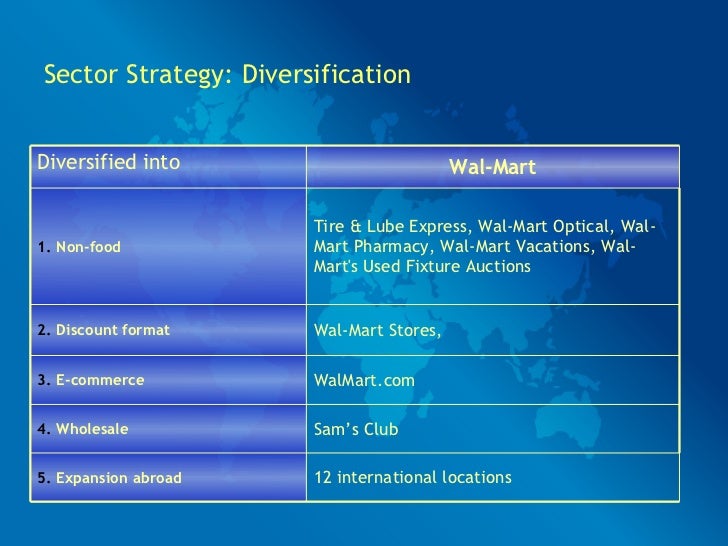Diversification strategy of walmart
The story of Wal-Mart Stores Inc. In addition, the forest analogy gives us insight into the process of organizational renewal — a challenge that faces many corporations and institutions in the West.
The development of a forest, or forest succession , in a temperate climate begins in an open patch of land that provides equal access to sun and rain. Its initial colonizers are migrants — weeds and wandering animals that spread seeds. These colonizers are the entrepreneurs of the ecosystem. They are attracted by the ready availability of small-scale resources and the absence of competition, a combination that enables everything to grow like crazy.
Entrepreneurial merchant Sam Walton perfected a way to make profits from small outlets in sparsely populated rural areas, which he often identified from the air.
His first store was only 16, square feet; subsequent stores were even smaller, at 12, square feet. Because of the absence of competition in small towns, Walmart grew like a weed. Walton, the wanderer, had a network of 24 stores in Arkansas before he moved into neighboring states, still pursuing a rural strategy and avoiding competition in denser population centers.
This was in the s, when the development of the suburban mall was well under way and many retailers, like Kmart and Sears, Roebuck and Company, were pursuing economies of scale.
Stratrgy Development of Wal-Mart | Gary Tarafder - pezewehemave.web.fc2.com
Sears at this time could probably not have made a decent return from stores much under 50, square feet, and suitable locations were hard to find and were packed with competitors.
In the forest, the weeds and wanderers thrive in the open patches until they start to bump into one another. This creates competition for resources, and favors shrubs and plants that develop efficient infrastructures.
Their roots get to the water first, and the light gets to their branches and leaves first, helping them grow faster which then stunts the growth of their competitors. In turn, the shrubs are succeeded by softwood trees, which are complex, hierarchical organisms that use resources even more efficiently. Because traditional wholesalers refused to make small drop-offs on remote country routes, Walton was forced to develop his own distribution infrastructure. In the idealized forest succession, softwood trees are supplanted by hardwood trees, which vie for resources using different strategies.
In the mixed forests of the southeastern United States, for example, the longleaf pine gives way to the oak. The deciduous oak, however, sheds its leaves, which absorb and hold groundwater, damping any fire and creating a deep mold in which acorns can germinate.
Once established, the oaks will outcompete the pines. With the appearance of the hardwood trees, forest succession has reached its so-called climax phase. This used to be thought of as a state of equilibrium, but it is not. Reduction in the variety of organisms in the ecosystem leads inexorably to a lack of resilience in the face of change. Too many trees of the same species and similar age are vulnerable to the same challenges, such as wind, disease, and insect attack.
The conditions are now right for a sudden catastrophe that will sweep away mature growth and open up the system for renewal.
Stratrgy Development of Wal-Mart | Gary Tarafder - pezewehemave.web.fc2.com
As Walmart grew and encountered more competition, the size of its stores grew, too. By , they had reached an average size of more than , square feet, a ninefold growth over 48 years — the hardwood trees in the Walmart ecology.
With the twin advantages of innovation and scale, Walmart entered its climax phase. Thus far, Walmart has largely avoided the vulnerability inherent in this phase by adapting and diversifying.

The first is the original discount stores, of which there are , averaging , square feet. Their numbers are declining as they are replaced by the second type of store, the supercenters, of which there are now 2,, averaging , square feet. The third group is a recently added category of neighborhood stores, of which there are , averaging 42, square feet in area.
Walmart locates these latter outlets in areas that cannot justify larger stores. But like the forest, retail stores can fall prey to systemic problems in the climax phase. As enterprises such as Walmart perfect their recipe for success, their means have a habit of running away with their ends.
Otherwise the company can easily lose its sense of identity and, with that, its moral compass. Applying an ecological perspective to business yields some interesting insights about how to achieve sustainable success.
Organizations are conceived in passion and born in communities of trust. They grow through the application of reason and mature in power. Today Walmart looks like a huge monolithic structure, but it began life as a movement, fueled by the convictions of Sam Walton and his vision of service to a community. The only real choice is whether you will seek to anticipate it or have it thrust upon you and be forced to respond without the benefit of forethought.
Ecosystems need regular disruption to create the open patches necessary for renewal. Know that, conversely, change in the core is difficult because there is fierce competition for resources.
Success tends to perpetuate itself, leading to the growth of large, slow-moving systems and homogeneity, which then leads to a lack of resilience and vulnerability to catastrophic change. Look for openings on disturbed ground — turbulent markets where information is scarce and navigation is unclear. What economists call market failures, entrepreneurs call opportunities. In the lodgepole pine forests of the Western mountain ranges in North America, fire ends the climax phase.
The lodgepole is a self-pruner: As it ages, it drops its lower branches on the ground. Older trees also become vulnerable to attack by bugs, and are turned into standing firewood. As the fuel builds and the forest becomes more tightly connected, fire becomes inevitable, culminating in conflagrations like the massive Yellowstone fires of But forests need fire.
Fire tests the system and breaks down the tall hierarchies old trees that monopolize the resources, recycling them into nutrients. Indeed, fire marks the completion of one cycle for the forest.

It creates the open patches that attract the entrepreneurs. It makes way for variety to reenter the system, both in the form of the seeds and weeds and in the creation of multi-aged stands of the dominant species. Such an ecosystem is once again loosely connected because resources can flow through it in many ways. It is no longer vulnerable to being wiped out by a single event, and the perpetual cycle of forest succession begins again.
The Western world, led by the United States, is going through a testing time. We could do much worse than to take our cues to action from nature itself. Reviews and mentions of publications, products, or services do not constitute endorsement or recommendation for purchase. No reproduction is permitted in whole or part without written permission of PwC. The item has been saved.
Google Answers: Wal-Mart's Diversification
To access this feature, please SIGN IN or REGISTER. Are CEOs Less Ethical Than in the Past? Building Trust while Cutting Costs. The Neuroscience of Strategic Leadership.
Best Business Books From the Outside In. Creating a Strategy That Works. What Self-Made Billionaires Do Best.

Current Issue Outlook 20th anniversary. Thinking about your company as an ecosystem yields lessons for innovation, growth, and renewal. Illustration by Elwood Smith. Business Mastery in a Chaotic World Columbia University Press, SELECT YOUR FAVORITE QUOTE AND SHARE IT! The New Class of Digital Leaders 2. Which One Describes Your Company?
Three Promises Every Sales Team Needs to Make — and Keep 5. Getting to the Critical Few Behaviors That Can Drive Cultural Change by Kristy Hull.
Why the Construction Industry May Be Robot-Proof by Daniel Gross. Consistency Drives Success at Telus. Innovation from Farm to Table. Three Promises Every Sales Team Needs to Make — and Keep. The New Class of Digital Leaders. Two Simple Concepts for Thinking about the Future. How to Lead When Global Trust Is Plummeting. Realigning Business, Economies, and Society. Cracking the Code of Economic Development.
Contact Webmaster Powered by Raven Creative, Inc. Designed by Opto Design. Content Saved The item has been saved. Login Required To access this feature, please SIGN IN or REGISTER. There was an error. Why Walmart Is Like a Forest.